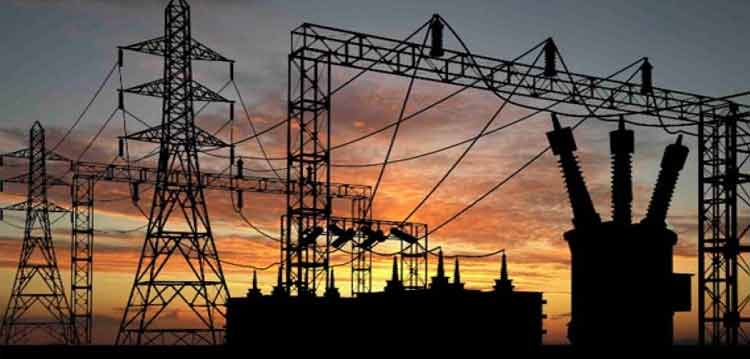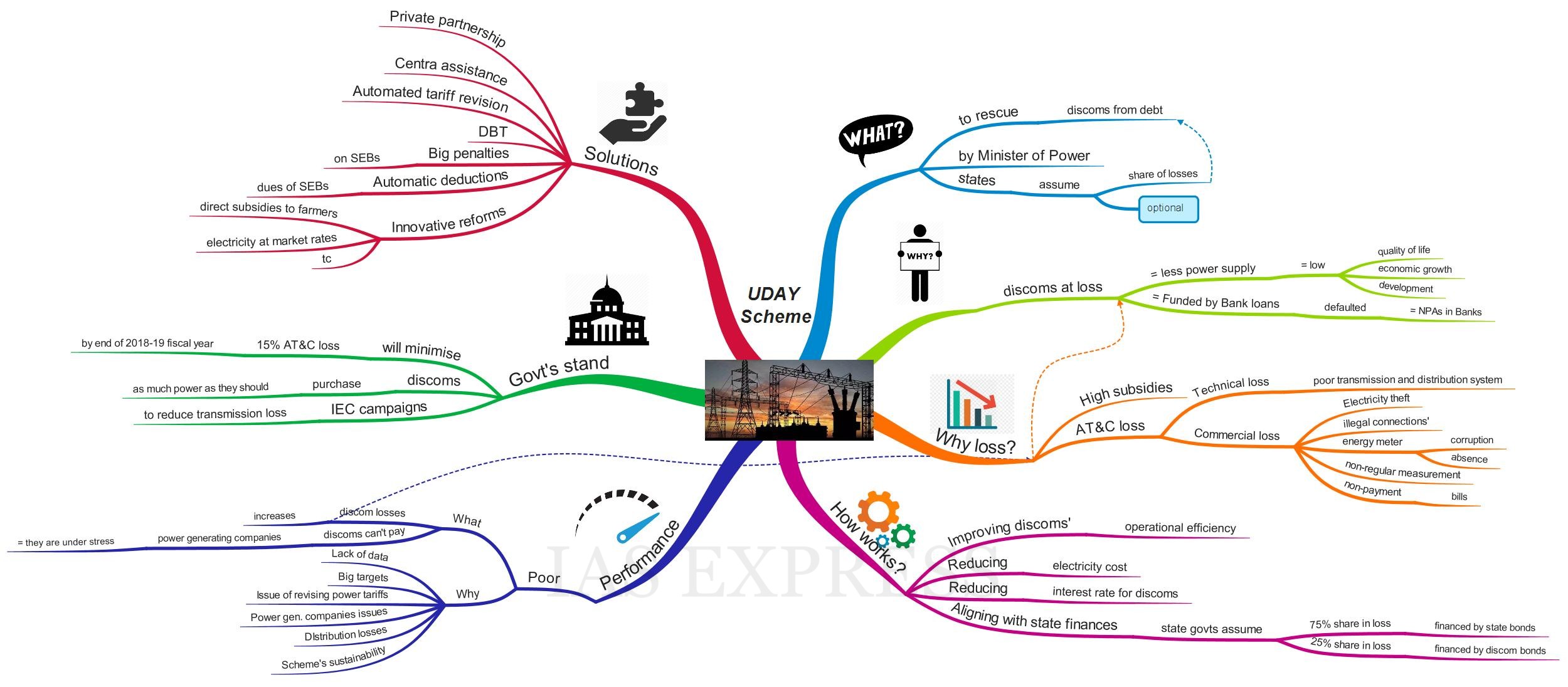UDAY Scheme – Is it still the Saviour of Power Sector?

From Current Affairs Notes for UPSC » Editorials & In-depths » This topic
IAS EXPRESS Vs UPSC Prelims 2024: 85+ questions reflected
Ujwal DISCOM Assurance Yojana (UDAY) is the financial turnaround and revival package for the electricity distribution companies of India (DISCOMS). It was launched with an aim to find a permanent solution to the financial struggle of the power distribution companies. However, even after 3 years of its implementation, the discoms continue to perform poorly. Therefore, urgent reforms are needed to address this issue and strengthen the power sector in India.
What is UDAY scheme?
- Ujwal DISCOM Assurance Yojana (UDAY) scheme was launched by the Union Ministry of Power in 2015.
- It seeks to rescue the State Electricity Distribution Companies from the huge amount of debts.
- 27 states and Union territories signed up for UDAY which freed discoms from the burden of debt that they carried.
- It committed states to assume a share of losses of the discoms starting from fiscal 2016-17.
- It has to be noted that, adopting UDAY is optional for states.
Why UDAY Scheme?
- Discoms in the country have accumulated losses of around Rs. 3.8 lakh crore and the outstanding debt of around Rs. 4.3 lakh crore (as on March 2015) = They can’t supply enough power at affordable rates, which affects the quality of life and overall economic growth and development.
- Besides, default on bank loans by financially stressed discoms can seriously impact the banking sector and the economy at large.
- Thus, discoms is trapped in a vicious cycle with operational losses being funded by the debt.
Why are discoms under debt?
Revenue-Expenditure mismatch
- There is a mismatch between the revenues and expenses of the discoms.
- The average revenue realised by discoms per unit of electricity distributed by them is Rs. 3.76, whereas, their cost of supply is Rs. 5.01 per unit = Deficit of Rs. 1.25 per unit. It is because of the following reasons.
Government Subsidies
- The rising base of rural electricity supply is increasingly subsidised and non-remunerative.
- Further, the recently launched Saubhagya Scheme, which ensures free electricity connections to village houses has created further anxieties among the states.
Power loss
- Aggregate technical and commercial losses (AT&C) losses in India is around 22% which is double the global average.
- AT&C losses provide a realistic picture of energy and revenue loss situation.
- AT&C losses consist of 2 elements: technical losses & Commercial losses
- Technical losses are due to energy dissipated in the conductors and equipment used for power transmission and distribution.
- A large amount of technical losses is due to the old and overloaded transmission and distribution system.
- Commercial losses are due to non-technical losses caused by energy theft, illegal connections on the distribution system, corruption of energy meter, non-regular measurement, absence of energy meters, non-payment of electricity used etc.
How does the UDAY scheme work? (also includes Merits of the scheme)
- It empowers discoms with the chance to solve their financial stress through 4 initiatives as follows.
- Improving operational efficiencies of discoms.
- Operational efficiency of discoms will be improved through initiatives like compulsory smart metering, upgradation of transformers, meters, special police to catch electricity thieves, etc.
- Energy efficiency measures such as efficient LED bulbs, agricultural pumps, fans & air-conditioners etc. will minimise the AT&C loss.
- Reduction of electricity cost.
- Reduction in electricity cost would be achieved via measures like the increased supply of cheaper domestic coal, coal linkage rationalization, faster completion of transmission lines etc.
- Reduction in interest cost of discoms.
- Implementing financial discipline on discoms by means of aligning with state finances.
- Under the scheme, state government assume over 75% share of debts of the state discoms and will issue bonds to finance this debt.
- Discoms are expected to issue bonds for the remaining 25% of their debt.
In short, UDAY would solve the issues of discoms = high demand for power from discoms = higher generation of power from generating units = lesser cost per unit of electricity = 24X7 power for all = Increase in economic activity + improve employment opportunities in the state.
How is the performance?
- Even after 3 years of its implementation, the scheme continues to perform poorly.
- The share of discom losses that states have to bear will increase from 5% in 2016-17 to 10% this fiscal and eventually to 50% by 2019-20.
- The discoms continue to be in trouble, unable to pay the power generating companies for their supplies.
- Around 21,000 MW of private coal-fired generation capacity is under stress due to the non-payment of debts by discoms.
- Discoms of states like Tamil Nadu, Madhya Pradesh, and Maharashtra have defaulted on their Power Purchase Agreements (PPA) obligations = these states are forcing the centre to consider options like giving more powers to regulators to penalise discoms.
What are the reasons for poor performance?
Lack of data
There is no data for 11 of the 27 states and Union territories committed for UDAY.
Big targets
- UDAY proposes a steep loss-reduction target for discoms to improve their financial health.
- However, it is near impossible because even 1% by states that opted for UDAY will result in Rs. 24,000 crore of cash losses unless offset by bigger tariff hikes and cost reduction measures.
Revision of power tariffs
- Though regulations require tariff revision, many states haven’t done it.
- Even those who have revised, the revision falls short of the estimates made under UDAY. The reasons are as follows
- Laxity of regulators.
- Tariffs remain a politically sensitive issue. For instance, Rajasthan had to roll back tariff increase for agricultural consumers by almost 25 paise resulting in an additional burden of Rs 500 crore.
Issues of power generating companies
- State Electricity Boards (SEBs) are delaying payments to power suppliers
- There are also regulatory dues or increases in tariffs due to new government levies like green cess or a port congestion surcharge.
- Cash strapped SEBs are not signing long-term power purchase agreement (PPAs) with generators who in turn are not in a position to repay their bank loans since they have no steady income stream.
Distribution losses
- Although UDAY succeeded in cutting down distribution losses by around 21%, a major share of losses is still left due to the following reasons
- Electricity theft has not been curbed completely.
- The inadequacy in metering and billing process.
- Most of the old transformers haven’t been replaced with new ones.
Sustainability of the scheme
- With several states missing the target over the 3 years, there are doubts over whether discoms could actually utilise this opportunity provided by the central government.
- Further, there is also a lack of strategy on dealing with failures to meet targets.
What is the government’s stand?
- The government is hoping to minimise the AT&C losses to 15% in the 2018-19 fiscal year.
- The discoms will start purchasing as much power as they should and stop load shedding, with the consumer meets all of their power needs from the grid.
- Transmission losses will be reduced by means of IEC (Information Education Communication) campaigns.
What could be done?
- Private partnership – Discoms should seek active support of private players, particularly in the high AT&C loss areas.
- Central assistance – Discoms should take the help of central government entities for better management and operational practices.
- Automate tariff revision
- Tariffs should be increased automatically for at least 3 years with respect to inflation or the percentage given in UDAY agreement, with no regulatory or political interference.
- This tariff system could be subjected to regulatory assessment after the end of the 3 year period.
- Direct Benefit Transfer (DBT) – To plug leakages in the power subsidies, states could utilise DBT to transfer the electricity subsidies.
- Big penalties – need to be levied on SEBs for non-supply of electricity. This will force them to sign PPAs. Also, when such big penalties are imposed and the cash balances of state governments are on the line, they will themselves petition their electricity regulators asking for tariff hikes and also work towards minimising theft rate which has large political patronage.
- Automatic deductions – Agreement need to be signed whereby the dues owed by SEBs are automatically deducted by RBI from the accounts of the state governments and paid to electricity suppliers.
- Innovative reforms – Setting up dedicated police stations for catching electricity thieves is a good idea, however, a better one would be to pay subsidies directly to farmers and others and sell electricity at market rates. Once this is done, the temptation to steal will automatically decrease.
If you like this post, please share your feedback in the comments section below so that we will upload more posts like this.


